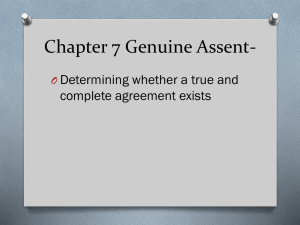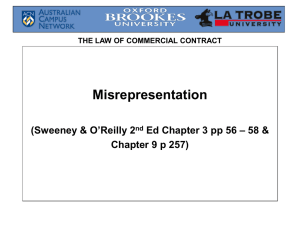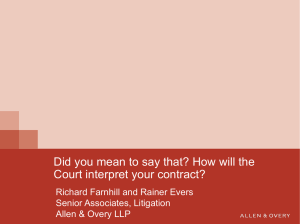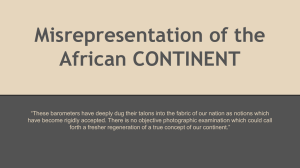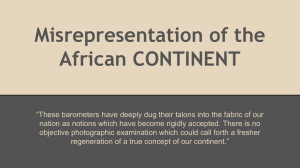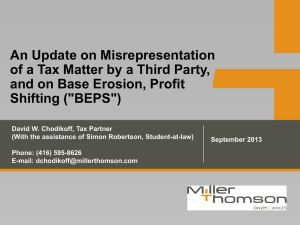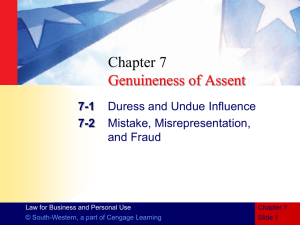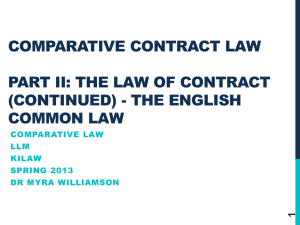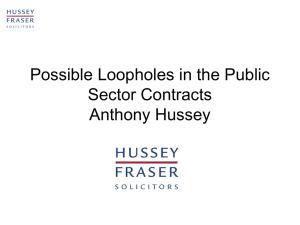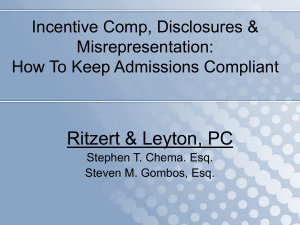Law of Contract Misrepresentation
advertisement
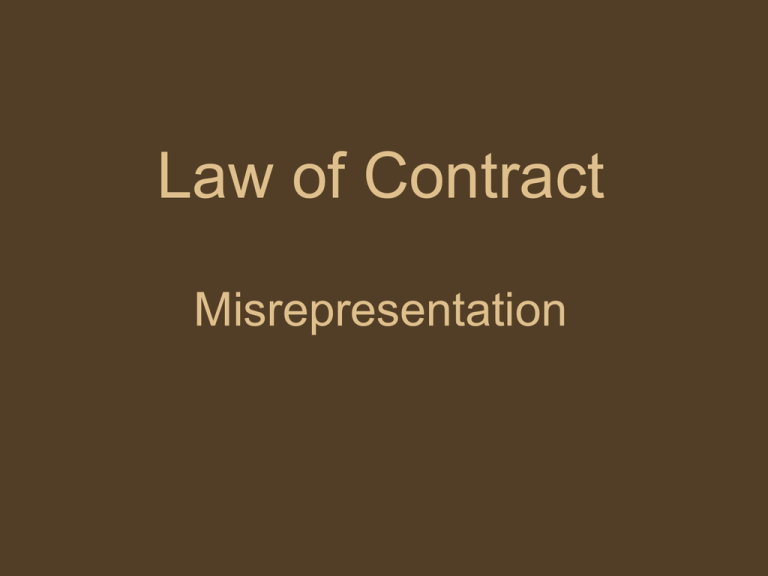
Law of Contract Misrepresentation Misrepresentation When negotiating a contract, the prospective parties may say many things which are designed to encourage the other party to enter into the contract. 1) Sometimes these become terms of the contract 2) Sometimes they do not become terms but may be representations (false statements) that may have induced the party relying on it, to enter into the contract. Misrepresentation Statements made by parties during the course of negotiations leading to a contract could either be, 1) Terms or 2) representations 3) or a mere puff Misrepresentation The distinction between a term and a mere representation is important because : 1) a failure to comply with a term results in a breach of contract, which entitles the party affected to repudiate/rescind the contract or enforce specific performance, or claim damages. 2) If a statement is a mere representation which is not complied with then it results in a claim for misrepresentation and thus damages or rescission in some cases. But see the result of the Misrepresentation Act 1967 Misrepresentation If the statement is found to be a representation and not a term of contract then we would have to ask if the statement was in fact a, Misrepresentation. Misrepresentation What is misrepresentation ? A misrepresentation may be defined as an “ Is an untrue statement of fact by one party which has induced, the other to enter into the contract” Misrepresentation Thus a misrepresentation is a : 1) statement of fact 2) addressed to the party that was misled as a result 3) statement induced the party into the contract Misrepresentation The statement may be in any form : 1) spoken 2) written 3) conduct May be expressed even by conduct Spice Girls Ltd v Aprilia World Service (2000) Facts : The participation by all five existing members of the spice girls pop group in an advertising shoot, was held to have carried the implication that none of them was planning to leave the group Held : When this turned out to be untrue, an action for misrepresentation was possible in relation to a sponsorship contract signed shortly after the shoot. Mere silence not misrepresentation Mere silence will not amount to misrepresentation. Fletcher v Krell (1873) Facts : A woman applied for the post of governess, without revealing that she had been previously married. At that time this may well have been a factor that would have affected the employer’s decision to employ her. Held : Silence alone would not amount to misrepresentation. But see exceptions below Silent Nondisclosure/misrepresentation If a statement which was true when made, becomes false as a result of changed circumstances, keeping silent, of the changed nature may be treated as a misrepresentation. With v O’Flanagan (1936) Facts : A doctor was selling his medical practice. He told a prospective buyer that it was worth £200 per annum, which was true at that time. The doctor fell ill and many of patients left him, and by the time the contract was signed, there was almost no income. Held : The failure to update the buyer on the developments amounted to misrepresentation. Silent Nondisclosure/misrepresentation A statement that is literally true, may be treated as a misrepresentation if “relevant’ information related to the statement is not disclosed Dimmock v Hallett (1866) Held : The statement that flats were let was true ; but the failure to disclose that the tenants had given notice to quit, turned it into a misrepresentation. Silent Nondisclosure/misrepresentation “Uberrimae fidei” contracts or contracts in “utmost good faith”. e.g. insurance contracts In contracts of this kind, the maker of statement is obliged to disclose relevant information, even if not asked for. Lambert v Co-operative Insurance society(1975) Statement of facts The following are not statement of facts : 1) statements of opinion or belief 2) statements of future conduct or intention Statements of Opinion or belief Bisset v Wilkinson (1927) Facts : The owner of a farm, which had never been used as a sheep farm, stated that he believed it would support a certain number of sheep (2000 sheep). Held : The court held that the statement was one of opinion and not fact, thus it was not a misrepresentation. But see Esso Petroleum Ltd V Mardon (1976) where Bisset was distinguished Statements of Opinion or belief Esso Petroleum Ltd v Mardon (1976) Esso represented to the defendant, a prospective tenant of a petrol filling station which was in the process of construction, that the throughput of petrol at the station was likely to reach 200,000 gallons per year. Unfortunately, it reached only 78,000 gallons and Mardon suffered losses. He could not pay Esso for their petrol and Esso sued, and Mardon counter claimed on misrepresentation Held : CA (Lord Denning) said that the statement was not an opinion but a statement as they had the special skill and knowledge and would have made the statement with “reasonable care and skill” Statements of intention or future conduct A statement of intention or future conduct, is not a statement of fact. Wales v Wadham (1977) e.g. Where one says “ over the next five years, our investment plans amount to five million pounds….etc” “The area around this building will be developed further and become a busy shopping area..” Statements of intention or future conduct But a person who misrepresents his “present” intention does make a false statement of fact Edgington v Fitzmaurice(1885) A company raised money from the public by saying that the money would be invested in the expansion of the business. The directors’ real intention was to use the money to pay off the company’s debts. Held : the statement was held to be a fradulent misrepresentation. Statement addressed to the party misled It must be shown that the representation was addressed to the party misled, either 1) by way of direct communication or 2) through a third party with the intention that it be passed on Statement addressed to the party misled Commercial Banking Co of Sydney v RH Brown and Co (1972) Facts : The defendant bank misrepresented to the claimant’s bank the financial standing of one of the claimant’s customers. The claimant’s bank communicated the information to the claimant’s customers. The claimant’s bank communicated the information to the claimants who acted on it to their detriment. Held : The Defendant’s were liable. Statement Induced the party The test of inducement is subjective and not objective. i.e Was the claimant in fact induced and did he rely on the statement. The onus will then be on the maker of the statement to proof that the receiver did not in fact rely on statement. Museprime Properties Ltd v Adhill Properties (1991) Statement Induced the party Not induced if relies on own judgement or investigation Attwood v Small (1838) Facts : The vendors of a mine made exaggerated statements as to its earning potential and the purchaser instructed a firm of expert surveyors to check the truth of the statements. The surveyors reported that the vendors statements were correct Held : The vendors were not liable - the purchasers had been “induced” to enter into the contract by the expert’s report and not by the vendors. Statement Induced the party It does not matter that party induced could have found out that it was not true because there was opportunity to do so. Redgrave v Hurd (1881) Facts : The purchaser of a solicitor’s practice had the opportunity to consult documents which would have revealed the falsity of the seller’s statement about the practice’s income. Held : The failure by the claimant in not doing his own ‘research’ will not stop him from making a claim in misrepresentation, if he was so induced. Types of misrepresentations Misrepresentation can be classed as : 1. Fraudulent 2. Negligent at common law Hedley Byrne v Heller (1964) 3. Negligent under statute S2(1) Misrepresentation Act 1967 4. Innocent Fraudulent Misrepresentation Derry v Peek (1889) as per Lord Herschell “A fraudulent misrepresentation is a false statement that is “made knowingly or without belief in its truth or recklessly, careless as to whether it be true or false” Note : the essence of fraud is the absence of honest belief. Fraudulent misrepresentation Derry v Peek (1889) Facts : A share prospectus falsely stated that the company had the right to use mechanical power to draw trams, without explaining that the government’s consent was required for this. In fact the directors honestly believed that obtaining consent was a pure formality, although it was ultimately refused. Held : The house of lords held that there had been no fraudulent misrepresentation Negligent Misrepresentation Negligent Misrepresentation under common law. Until 1963, damages could be claimed for misrepresentation only where it was fraudulent. All Non-fraudulent misrepresentations were classed as “innocent” and damages were not available for them. Negligent Misrepresentation In 1963, the HL stated, “obiter”, in Hedley Byrne & Co Ltd v Heller & Partners (1964) Held : A party can claim damages for negligent mis-statement under both tort and contract, where there was a “special relationship” between the parties. i.e the maker of the statement has some skill or knowledge and he could reasonably foresee that the other party would rely on the statement. Negligent Misrepresentation Negligent Misrepresentation under the : Misrepresentation Act 1967 S 2 (1) of the MA 1967, provides that “Where a party has entered into a contract after a misrepresentation has been made to him, by another party, and as a result has suffered loss, then, if the other party would be liable to damages in respect thereof had the misrepresentation had been fraudulent, the party who misrepresented, shall be so liable, not withstanding that the statement was not fraudulent..Unless he(maker of statement) proves that he had reasonable grounds to believe that the statement was true..” Negligent Misrepresentation Result of Misrepresentation Act 1967 : 1) The burden of proof is reversed to show “innocent” misrepresentation 2) Claimant can choose to rely either on common law or statute 3) There is no need to show “special relationship’ under the statute unlike common law, Hedly Byrne v Heller requirement. Negligent Misrepresentation The courts relied on S2(1) of the Misrepresentation Act 1967, to hold Spice Girls Ltd liable to Aprilia Spice Girls Ltd v Aprilia World Service (2002) Facts : Ms Halliwell, one of the Spice Girls, had declared her intention to leave the group before, the agreement was signed. Aprilia was not informed of this. The commercial shoot with all the girls was done. If Aprilia knew that Ms Halliwell would leave the group the contract would not have been signed. Held : The CA held there was misrepresentation under S2(1)
